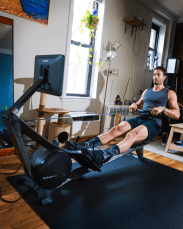Rowing is one of the best workouts you can do at home thanks to its low-impact nature and ability to target multiple muscle groups at once.
While there are plenty of positives that can come from even a short rowing workout, athletes really begin to see the benefits once they match their sleek at-home equipment with a proper stroke.
Now, if you’re just realizing that rowing is a skill set and there’s an actual right and wrong way to use these machines, don’t fret. We spoke to Austin Hendrickson, lead trainer at Aviron and owner of Training Tall, to identify some surprising tips to help take your strokes up a notch (or seven).
First, Why Is Rowing Form Even Important?
Because rowing employs so many muscles in a singular movement, you want to ensure you do it properly not just for efficiency’s sake but safety as well.
“By having good form, you can essentially eliminate all injury risk, whatsoever.”
“One of the most common injuries we see with people using improper rowertechnique is lower back injuries,” Hendrickson says. “That’s because of the dynamic body lean and swing that we see throughout the stroke.
“By having good form, you can essentially eliminate all injury risk, whatsoever.”



